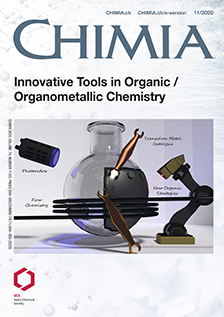Advances in the Synthesis of Fluorinated Scaffolds by Transition Metal-Catalyzed C–H Bond Activation
DOI:
https://doi.org/10.2533/chimia.2020.871PMID:
33243322Keywords:
C–h bond functionalization, Emergent fluorinated groups, Organofluorine chemistry, Synthetic methods, Transition metalAbstract
Thanks to the unique features of the fluorine atom and the fluorinated groups, fluorine-containing molecules are essential. Therefore, the search for new fluorinated groups as well as straightforward and original methodologies for their installation is of prime importance. Especially, the combination of organofluorine chemistry with transition metal-catalyzed C–H bond functionalization reactions offered straightforward tools to access original fluorinated scaffolds. In this context, over the last years, our group focused on the development of original methodologies to synthesize fluorine-containing molecules with a special attention to emergent fluorinated groups. The present account highlights our recent contributions to the synthesis of highly value-added fluorine-containing compounds by transition metal-catalyzed C–H bond activation.Downloads
Published
2020-11-25
Issue
Section
Scientific Articles
License
Copyright (c) 2020 Sara Mazeh, Maria Ivana Lapuh, Tatiana Besset

This work is licensed under a Creative Commons Attribution-NonCommercial 4.0 International License.
How to Cite
[1]
S. Mazeh, M. I. Lapuh, T. Besset, Chimia 2020, 74, 871, DOI: 10.2533/chimia.2020.871.







